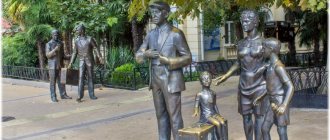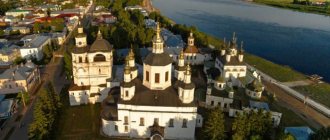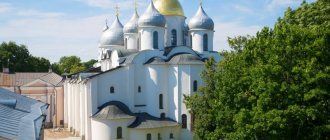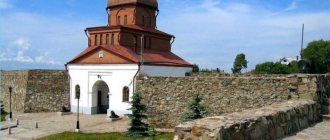The monument to Catherine 2 in Krasnodar is one of the “business cards” of the southern metropolis. The “capital” of Kuban is an agglomeration where the past is amazingly preserved (in the historical part all the houses have been preserved, and the signs contain old street names). At the same time, one can also read the future – the skyscrapers here are grandiose. Lots of transport, elegant forging, spacious beautiful avenues and theme parks.
History of the attraction
The idea for the original sculpture was born back in 1895 - from the sculptor Mikeshin. A year later, the general sketch was ready and the pedestal was laid. The plot was supposed to be Catherine the Great and her victorious entourage, because it was the named empress who ordered the construction of a city on the border of the stanitsa and Adyghe settlements of Kuban. It is no coincidence that it initially bore the name Ekaterinodar. And history has preserved information that the enlightened queen allowed the Cossacks to settle in this place back in 1793. Many local historians even know the date of the first settlement and mark it.
It’s worth talking about Catherine Square itself. Its territory is officially considered by historians to be the founding point of modern Krasnodar - in the 90s. In the 18th century, on the site of this green zone there was a palace park of the Black Sea Ataman. The windows of the residence overlooked magnificent alleys and gardens. By the way, a Ginkgo tree, brought from China, grew here. Then it was called a “living fossil” or “the progenitor of all trees.” “Green Brother,” by the way, still smells here today. He is the only inhabitant of the garden to whom nothing bad has happened during his life.
But we will continue to consecrate the history of the monument. After Mikeshin's death, Boris Edwards continued his work. The opening of the monument took place only in the late spring of 1907. Later, it was sent by the metal-hungry Bolsheviks to be melted down, having stood for only 13 years.
A new hypostasis was created by A. Apollonov, a member of the Russian Union of Artists. He studied the bronze copy of the sculpture, the papers and the drawings. The facility was restored according to his design in 2006. The townspeople saw the fruits of the work in the workshop, as well as triumphal paraphernalia made by specialists from the local Compressor Plant. The veil was removed to the music of the memorial concert, after a fiery speech by the Krasnodar leadership about “our heroic ancestors.” On the date of the landing of the first Black Sea landing, flowers are laid here.
Read what to see in Krasnodar in a day.
Where to eat nearby
Another thing I would like to mention is the coffee. I walked there in the winter-spring period, so even though it was south, I wanted to warm up. One day I found one establishment (it’s hard to call it a cafe, because the establishment doesn’t even have its own name) while walking down the street looking for a gift and going into all the shops I came across. So, since the door was still there, albeit without a sign, and rather inviting-looking, I decided to try to get inside.
This place turned out to be a small buffet in a strange style, either vintage or, on the contrary, modern eco. Lots of wood, the smell of oranges and coffee, a small counter with local pastries and a couple of chairs along the window. You can have a snack, look out the window at the city (although there are not many people in this area during the cold season), no one will bother you. One way or another, I went to this place almost every day. If anyone is interested, the address is: Krasnaya, 16, transparent door next to Kubanloto.
Walk at the monument to Catherine II
In Krasnodar, the monument to Catherine 2 is the compositional center of the named public garden. Fulfilling his idea, the author of the reconstruction sculpture conveyed the essence of the old version of this composition. Catherine the Second appears before us in majestic vestments - in a mantle, with an orb and a scepter. The text of the Charter (Complaint) dated July 1, 1792 is also engraved.
On the left side is shown Prince Potemkin-Tavrichesky - opposite battle flags and Zaporozhye military standards. On the right are the three oldest atamans (koshevs) of the new (Black Sea) Cossack army: A. Golovaty, S. Bely and Z. Chapega. On the reverse of the monument we see a blind kobzar with a guide. There is also a list of victories won by Catherine’s Russia. Precisely those where the Kuban Cossacks participated. The composition is made of bronze, cast iron, aluminum and even gold elements (gold leaf)! And its height (with pedestal) is almost 14 m.
The granite pedestal is surrounded on all sides by sidewalks, benches and a cascading fountain. The square is surrounded by flower beds of different shades. It is filled with unique smells. Are you hungry? To yours, Ozzy Pizza, GorPark diner. Do you want to spend the night here? The building of the Platan hotel establishment is a two-minute walk away.
Monument in the life of Krasnodar
There is a belief that Saint Catherine is able to protect everyone who turns to her with such a request from mistakes and dangers. It helps to find peace in the family and well-being in the home, protects and helps pregnant women, protects newborns from illnesses, and helps to find a faithful life partner.
Therefore, here you can often see townspeople and guests of Krasnodar reading a prayer to the Holy Great Martyr Catherine, revered as an example of piety and a helper in good deeds.
In the life of the city, the monument has become a traditional place where newlyweds come on their wedding day. Passing under the figure of the Saint, the lovers ask to bless and strengthen their union.
Click to open in a new tab
How to get there (get there)?
The building is easy to find in the green zone, where you get from the stop of trams 4 and 2. It is called the City Garden (it lies further south). After getting off the tram, slowly move towards Catherine Park along Lilac Alley.
How to get here by car:
Note to tourists
- Address: Catherine Square, Krasnodar, Russia.
- GPS coordinates: 45.015436, 38.968362.
Be sure to visit Krasnodar during your vacation. The monument to Catherine II should become one of the obligatory points of a “homemade” city tour. So, you are already studying a photo of an interesting sculpture on our portal. All that remains is to visit Catherine Square in real life to make a memorable photo shoot here. The facts speak for themselves - the composition is triumphant, catches the eye, and is a good background for the photo. Feedback from tourists calls it “the gratitude of the Cossacks,” “a beautiful landmark,” and even “the oldest point on the city map.” Perhaps, considering that next door the restored Main Military Church also sparkles with domes (and after all, churches were built in the center). In conclusion, we offer a video walk to the place, enjoy watching!
City's legends
It is believed that countless treasures were originally laid under the empress’s monument. It all started with the fact that one ardent lady of great wealth threw a ring at the feet of the ruler’s monument as a sign that once her relative did not achieve the due honor from Catherine II, and now she does not need the jewelry that she got with such difficulty and passed down the family line . That is why not only newly-made spouses, but also wealth seekers come here in the hope of the favor of Her Imperial Majesty.
The Holy Great Martyr Catherine, the patroness of Ekaterinodar (Krasnodar), stands on a huge pedestal in the form of a bell, decorated with four gilded angels.
According to the authors of the project, Moscow sculptors Vitaly Shanov and Daria Uspenskaya, anyone can go inside the bell and ask for the saint’s heavenly protection. The newlyweds were the first to pass under the shadow of Saint Catherine, having received her unspoken blessing. This happened during the opening ceremony of the monument and became a beautiful wedding tradition in the city.
“Today we consecrated a wonderful monument that adorns our beautiful city, the capital of our Kuban, which will gather us here to reflect on the eternal. Saint Catherine will protect our city from enemies visible and invisible, and everyone who comes to her will receive what they ask for,” Metropolitan Isidore said during the consecration ceremony.
The almost eight-meter monument is made of bronze; it took the author a year and a half to make it. The magnificent sculpture was unveiled and dedicated on April 24, 2009.
Brief Life of the Holy Great Martyr Catherine
Saint Catherine was born in Alexandria in the second half of the third century. She came from a noble family and was distinguished by her bright mind, learning and beauty. Many rich and noble suitors sought her hand, and her mother and relatives persuaded her to agree to marriage. But Catherine was slow to answer and told her loved ones: “If you want me to get married, then find me a young man similar to me in beauty and learning.”
God arranged it in such a way that Catherine met one hermit elder, a man of a bright mind and a righteous life. Discussing with Catherine the merits of her suitors, the elder said: “I know the Bridegroom who is superior to you in everything. There is no one like him." Then he gave her an icon of the Blessed Virgin, promising that it would help her see the extraordinary Bridegroom.
The next night, Catherine imagined in a light dream that the Heavenly Queen, surrounded by angels, was standing in front of her and holding in her arms the Child, shining like the sun. In vain did Catherine try to look at His face: He turned away from her. “Do not despise Your creation,” the Mother of God prayed to her Son, “tell her what she must do to see Your bright face.” “Let her return to the elder and find out from him,” answered the Youth. The wonderful dream deeply struck the girl. As soon as morning came, she hurried to the old man, fell at his feet and asked him for advice. The elder explained to her in detail the true faith, told her about the heavenly bliss of the righteous and the death of sinners. The wise virgin understood the superiority of the Christian faith over the pagan faith, believed in Jesus Christ as the Son of God and accepted holy baptism. After her baptism, divine light penetrated her and filled her with great joy. When Catherine returned home with a renewed soul, she prayed for a long time, thanking God for the mercy shown to her. Having fallen asleep during prayer, she again saw the Mother of God. Now the Divine Youth looked at her graciously. The Most Holy Virgin took the maiden’s right hand, and the Youth put on her a wonderful ring, saying: “Know not the earthly bridegroom.” Catherine realized that from that moment she was betrothed to Christ and woke up with even greater joy in her heart. After that, she completely changed and became modest, meek and merciful. She began to pray to God often, asking for guidance and help. One goal inspired her: to live for Christ.
Soon, Maximian (286-305), co-ruler of Emperor Diocletian, arrived in Alexandria. He sent messengers to the cities of Egypt to convene the people for a holiday in honor of the pagan gods. Catherine mourned that the tsar, instead of helping to educate the people, was further instilling pagan superstitions. When the holiday arrived, she came to the temple where the priests, nobles and people gathered and fearlessly said to the king: “Aren’t you ashamed, king, to pray to vile idols! Know the true God, beginningless and infinite; to them kings reign and the world stands. He came down to earth and became a man for our salvation.”
Maximian was angry with Catherine for disrespecting his royal dignity and ordered her to be imprisoned. Then he ordered learned people to convince Catherine of the truth of the pagan religion. For several days, they presented to the girl various arguments in favor of the pagan religion, but Catherine, with her logic and reasonable arguments, smashed them to dust. She proved to them that there can only be one wise Creator of everything, who with his perfections infinitely rises above the pagan deities. In the end, the pagan sages admitted themselves defeated by Catherine’s all-crushing logic. Having failed on intellectual grounds, Maximian, however, did not give up on his intention to convince Catherine. Having called her, he tried to seduce her with gifts, promises of honors and glory. But Catherine remained incorruptible.
Maximian had to leave the city for a short time. His wife, Queen Augusta, who had heard a lot about Catherine's wisdom, wanted to see her. Having met and talked with Catherine, Augusta believed in Christ and accepted the Christian faith.
When Maximian returned to Alexandria, he again sent for Catherine. This time he took off the mask of goodwill and began to threaten Catherine with torture and death. Then he ordered wheels with sharp teeth to be brought and ordered her to be put to this terrible execution. But as soon as the torment began, an invisible force crushed the instrument of torment, and Saint Catherine remained unharmed. Queen Augusta, having learned about what had happened, appeared before her husband and began to reproach him for how he dared to rebel against God Himself. The king was furious at his wife’s interference and ordered her to be killed immediately.
The next day, Maximian called Catherine for the last time and invited her to become his wife, promising her all the blessings of the world. But Saint Catherine did not want to hear about it. Seeing the futility of all his efforts, the king ordered her to be put to death, and the warrior cut off her head in 304.
Subsequently, the holy remains of the Great Martyr Catherine came to Mount Sinai and since then have been kept here in a monastery named after her. Emperor Peter the Great donated a precious shrine to her relics. (taken from www.sedmitza.ru) (read the full life on www.pravoslavie.ru)










